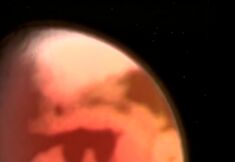Mars was a planet in the solar system. It was next planet away from the Sun after Earth.
Astronomical data
Location
Mars, much like its neighbouring planet of Earth, was in the solar system. It orbited the Sun, its local star, which provided it with light and to some extent, heat. (WC: Star Cops The High Frontier)
Moons
TBA
Atmosphere and gravity
Despite having gravity, it was only roughly half of Earth's gravity, as noted by Colin Devis. Mars' atmosphere was thin, meaning that no liquid water existed on its surface. That made water very scarce and highly regulated, meaning that water theft was a serious crime and a reason for deportation back to Earth with no need for trial or investigation.
As part of the human race's attempts to terraform Mars, they had erected the Stacks at regular points around the planet, which pumped fluorocarbons into the atmosphere, encourage climate change, the hopes it would make the planet hospital at some point in its future. (AUDIO: The New World)
Geography
Mars' surface was a shade of orange. It was rocky, sandy and extremely arid. (WC: Is there crime on Mars?) Three hours from the Barack Obama Base was Olympus Mons, the highest mountain in the solar system. It was three times as high as Everest, and was even wider than the Grand Canyon. (AUDIO: The New World)
One of the Stacks was located at the Solis Planum, a volcanus crater over a thousand miles wide. Holmberg explained to Devis that there were once many volcanoes on the surface on Mars that were now dormant. In their wake, they left caverns or "lava tubes" that one could enter like caves. She explained that ice often formed in lava tubes, causing some to go excavating on their "ice hunts". (AUDIO: The New World)
History

Early settlements
The first settlement on Mars was the Barack Obama Base, coordinated by Barbara Holmberg. As further settlements and outposts were founded, the Barack Obama Base became the main entry to the planet, acting as a spaceport. (AUDIO: The New World)
Early in Nathan Spring's tenure of Commander of the ISPF, a supposed Martian artefact was being transported to Moonbase for further investigation. It was at this time that two pilots flying from Mars were both killed in shuttle explosions. After investigation, the ISPF discovered that the artefact was in fact a Mayan sculpture buried on the surface by smugglers until the time was right to "make the discovery". (TV: Little Green Men and Other Martians)
It was following this investigation that Spring made it his mission to put "Star Cops" on Mars. He was prepared to make it a two year mission. Unfortuately, this plan would be delayed due to the uprising of anti-space colonising terrorist group Mother Earth. (TV: Little Green Men and Other Martians, One of Our Cops is Missing, et al)
Following the dissolution of Mother Earth, Spring and Devis investigated the death of two people on the Edgar Rice Burroughs space station due to a mysterious disease. The Edgar Rice Burroughs acted as a way station between Earth and Mars, so that Mars would not have to rely on Earth shuttles for deliveries. Every twenty-six months, Mars would enter an "optimal window", making travel between the Edgar Rice Burroughs and Mars roughly seven months, using the Pellucidar and Caprona ships. (AUDIO: The Stuff of Life)
The New World
TBA
Futher incidents
Before being briefed on the incident regarding Sonia Garrett, and the looming threat of the Collective, Spring recalled how Mars had become part of "his territory". (WC: Star Cops The High Frontier)
Politics
Other references
- There are two known news stations on Mars, namely Cosmopolitan News and Atlas News. (TV: Little Green Men and Other Martians)
- There is no available video link between Moonbase and Mars. (TV: Little Green Men and Other Martians)
Behind the scenes
- TBA